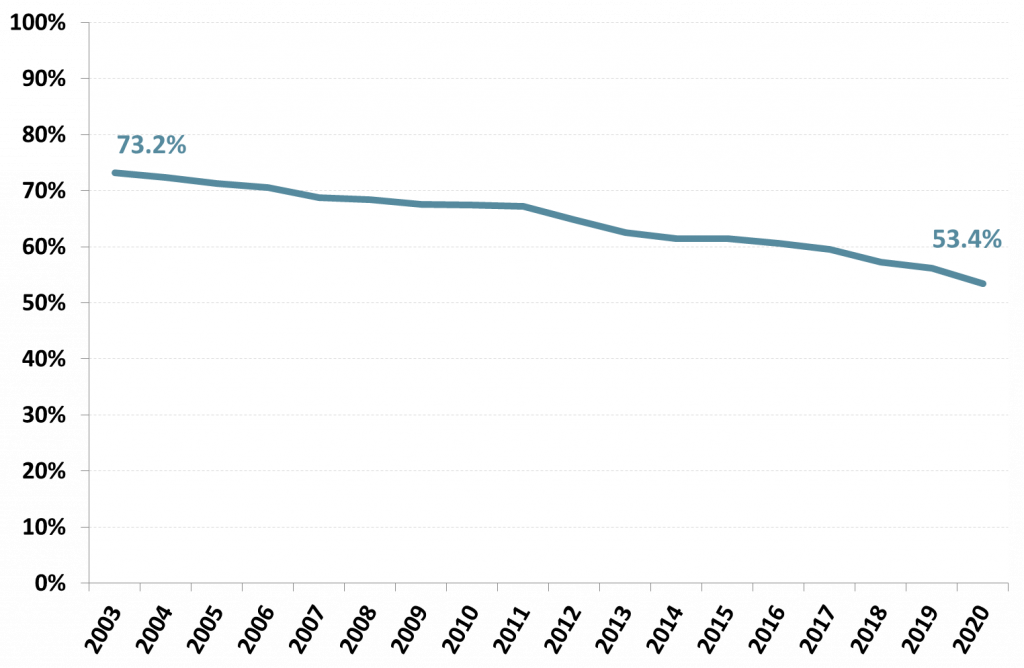The shrinking proportion of religious Australians

Newly released Roy Morgan data shows a significant drop in the number of Australians who say they hold religious beliefs. However, the percentage who report regularly attending a place of worship has remained remarkably steady.
Roy Morgan’s Single Source is the nation’s largest and longest-running survey of Australians, covering values, beliefs, behaviours, concerns, aspirations and almost every other facet of life. For close to two decades, this extensive survey has included questions about religion and in 2003, almost three-quarters of the population (73.2%) nominated a religion to which they belonged. By the end of 2020, that figure had fallen to just over half (53.4%).
Respondents are free to nominate any religion. In 2003, 68.1% of the population described themselves as Christian. As of 2020, that was down to 44.0%.
Meanwhile the proportion of Australians who describe themselves as having no religion has risen from 26.0% in 2003 to 45.5% in 2020.
Yet despite these significant changes, the percentage of Australians who say they regularly attend a church or other place of worship has changed very little, from 18.8% in 2003 to 17.4% in 2020.
The information is drawn from large-scale surveys, with a yearly average of more than 17,000 respondents over the 18-year period covered by this data.
Roy Morgan CEO Michele Levine says:

“Australia and Australians have changed in many different ways over the past two decades or so, and changes in the part religion plays in people’s lives is a prime example.
“In 2003 a large majority of the population (73.2%) said they belonged to a religion. Now, that has fallen to 53.4%. That’s a decrease of almost 20% of people. There has been a drop of over 24% in those who describe themselves as Christian, from a majority of 68.1% to a minority of 44.0% over that period.
“However, while the percentage of the population who hold religious beliefs has dropped markedly, the percentage who say they regularly attend a church or other place of worship has remained remarkably consistent: 18.3% in 2003, compared to 17.4% in 2020. The key word here being “regularly” — we’re coming up to Easter which, along with Christmas, sees the regulars numbers boosted by others making annual or biannual ‘special celebration’ visits to church.”
% of Australians who hold religious beliefs: 2003 – 2020

Source: Roy Morgan Single Source, January 2003 – December 2020, annual average n=53,128.
Base: Australians aged 14+.
Question: “Would you please tell me your religion?”
Margin of Error
The margin of error to be allowed for in any estimate depends mainly on the number of interviews on which it is based. Margin of error gives indications of the likely range within which estimates would be 95% likely to fall, expressed as the number of percentage points above or below the actual estimate. Allowance for design effects (such as stratification and weighting) should be made as appropriate.
| Sample Size | Percentage Estimate |
| 40% – 60% | 25% or 75% | 10% or 90% | 5% or 95% | |
| 1,000 | ±3.0 | ±2.7 | ±1.9 | ±1.3 |
| 5,000 | ±1.4 | ±1.2 | ±0.8 | ±0.6 |
| 7,500 | ±1.1 | ±1.0 | ±0.7 | ±0.5 |
| 10,000 | ±1.0 | ±0.9 | ±0.6 | ±0.4 |
| 20,000 | ±0.7 | ±0.6 | ±0.4 | ±0.3 |
| 50,000 | ±0.4 | ±0.4 | ±0.3 | ±0.2 |
